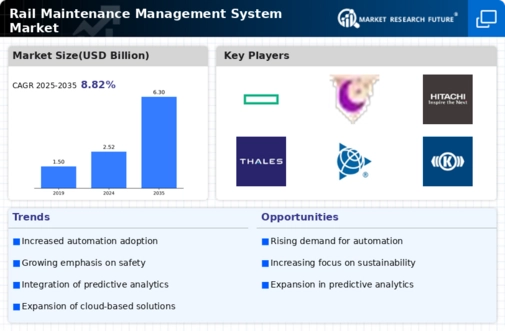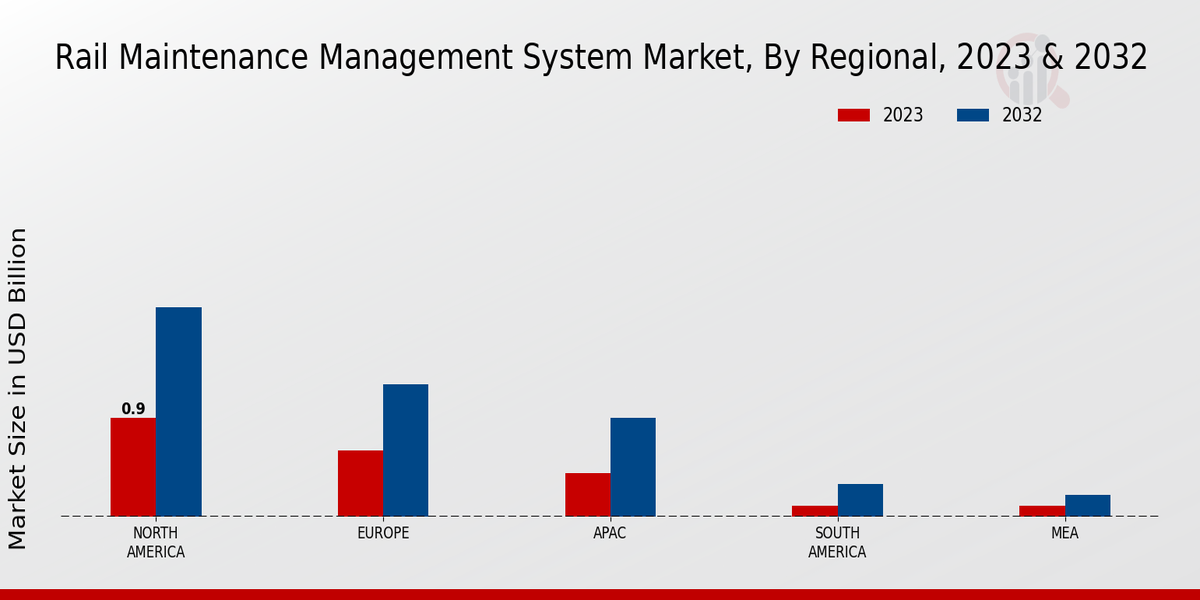Market Growth Projections
The Global Rail Maintenance Management System Market Industry is poised for substantial growth, with projections indicating a market size of 2.52 USD Billion in 2024 and an anticipated increase to 6.3 USD Billion by 2035. This growth trajectory suggests a robust compound annual growth rate (CAGR) of 8.69% from 2025 to 2035. Factors contributing to this growth include technological advancements, increased government investments, and a heightened focus on safety and compliance. These elements collectively indicate a promising future for the rail maintenance management sector, as stakeholders recognize the critical role of effective maintenance in sustaining rail operations.
Growing Focus on Safety and Compliance
The emphasis on safety and compliance within the rail industry significantly influences the Global Rail Maintenance Management System Market Industry. Regulatory bodies worldwide are imposing stringent safety standards, compelling rail operators to adopt comprehensive maintenance management systems. These systems facilitate compliance with safety regulations by ensuring that maintenance activities are documented and executed effectively. For example, adherence to safety protocols can prevent accidents and enhance public trust in rail services. As safety becomes a priority, the market is likely to witness sustained growth, driven by the need for systems that support compliance and enhance operational safety.
Rising Urbanization and Population Growth
Rising urbanization and population growth are pivotal factors driving the Global Rail Maintenance Management System Market Industry. As urban areas expand, the demand for efficient public transportation systems increases, leading to greater reliance on rail networks. This trend necessitates effective maintenance management to accommodate the growing passenger volumes and ensure service reliability. For instance, cities like Tokyo and New York are investing heavily in their rail systems to meet the demands of urban populations. Consequently, the market is expected to grow at a CAGR of 8.69% from 2025 to 2035, reflecting the increasing need for maintenance solutions in urban rail systems.
Government Investments in Rail Infrastructure
Government investments in rail infrastructure are a significant driver of the Global Rail Maintenance Management System Market Industry. Many countries are prioritizing rail transport as a sustainable alternative to road transport, leading to increased funding for rail projects. This investment not only enhances the quality of rail infrastructure but also necessitates robust maintenance management systems to ensure longevity and safety. For instance, initiatives in regions such as Europe and Asia are focusing on modernizing rail networks, which inherently boosts the demand for maintenance solutions. This trend suggests a strong correlation between infrastructure investment and the growth of the maintenance management market.
Increasing Demand for Efficient Rail Operations
The Global Rail Maintenance Management System Market Industry is experiencing heightened demand for efficient rail operations. As rail networks expand globally, the need for effective maintenance solutions becomes paramount. This demand is driven by the necessity to minimize downtime and enhance service reliability. For instance, rail operators are increasingly adopting advanced maintenance management systems to streamline operations and reduce costs. The market is projected to reach 2.52 USD Billion in 2024, reflecting a growing recognition of the importance of maintenance in ensuring operational efficiency. This trend indicates a shift towards proactive maintenance strategies that can significantly improve rail service delivery.
Technological Advancements in Maintenance Solutions
Technological advancements play a crucial role in shaping the Global Rail Maintenance Management System Market Industry. Innovations such as predictive analytics, Internet of Things (IoT), and artificial intelligence are transforming traditional maintenance practices. These technologies enable real-time monitoring and data analysis, allowing for timely interventions and reducing the likelihood of equipment failures. For example, IoT sensors can provide critical data on track conditions, facilitating proactive maintenance. As a result, the market is expected to grow significantly, potentially reaching 6.3 USD Billion by 2035, driven by the increasing adoption of these advanced technologies in rail maintenance.






















